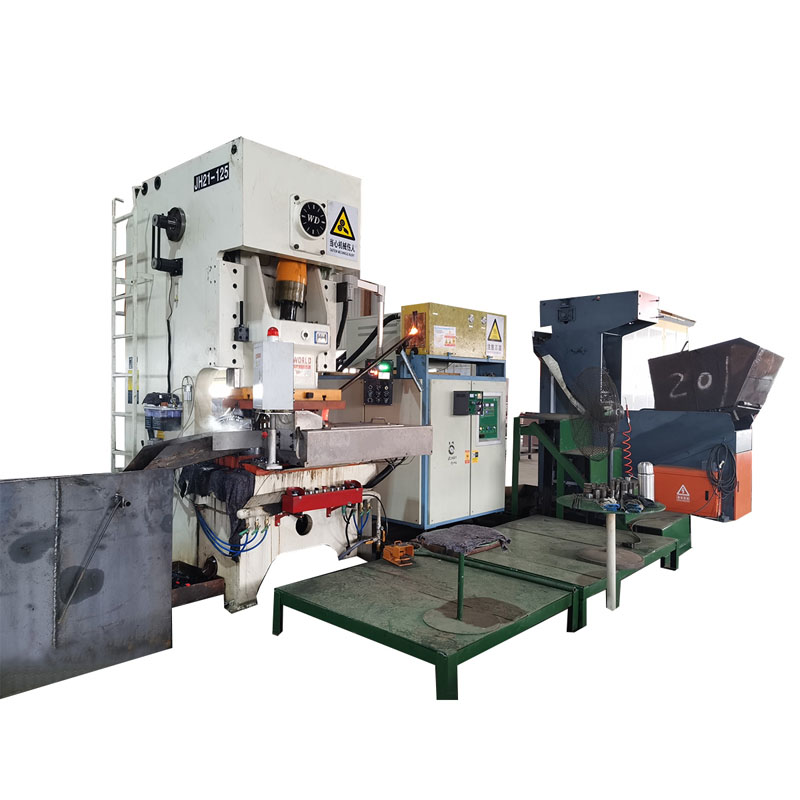How Does a Nut Part Hot Forging Machine Revolutionize the Manufacturing of High-Quality Fasteners?
2025-02-20
In the world of manufacturing, producing high-quality, durable fasteners is a critical aspect of various industries, from automotive to aerospace. Among the methods used for crafting these essential components, the hot forging process stands out as one of the most efficient and reliable. A Nut Part Hot Forging Machine, specifically designed for the production of nut parts, plays a crucial role in ensuring the precision, strength, and reliability of fasteners. But how does this machine work, and why is it so essential for manufacturers today?
What Is Hot Forging and Why Is It Used for Nut Parts?
Hot forging is a process that involves shaping metal by applying high heat and mechanical force. In hot forging, the metal is heated to a temperature where it becomes soft and malleable, usually between 800°C and 1,200°C, depending on the material. At this stage, the heated metal can be easily shaped into the desired form using a forging machine.
For nut parts, hot forging offers several advantages over cold forging or casting methods. The high heat allows for better material flow, which reduces internal stresses and makes the final product stronger and more durable. This is particularly important for nut parts that are used in demanding applications, such as engines, machinery, and infrastructure, where strength and precision are essential.
How Does a Nut Part Hot Forging Machine Work?
A Nut Part Hot Forging Machine is designed to carry out the forging process in a controlled and precise manner. These machines typically consist of a forging press, a heating system, and a die set. Let’s break down the key steps involved in the process:
1. Heating the Material: The raw material, typically a metal billet or bar, is first heated in a furnace to the appropriate temperature. The precise temperature control is essential to ensure that the material becomes malleable without losing its structural integrity.
2. Shaping the Nut Part: Once the material reaches the correct temperature, it is fed into the forging press. The press applies significant force to shape the material into the desired nut shape, using specially designed dies. The die set for nut parts will have cavities that are specifically designed for the different sizes and types of nuts being produced.
3. Cooling and Finishing: After the nut parts are forged, they are cooled, often in a controlled environment, to prevent distortion. Some machines may also include additional finishing processes, such as trimming, machining, or surface treatment, to ensure the nut parts meet the required specifications.
Why Is a Nut Part Hot Forging Machine Important?
1. High Precision and Consistency
One of the primary benefits of using a Nut Part Hot Forging Machine is its ability to produce nuts with high precision and consistency. The forging process ensures that the material is evenly distributed and free from internal defects, resulting in nut parts that are both strong and dimensionally accurate. This precision is essential for applications where tight tolerances are required, such as in automotive and aerospace components.
2. Strength and Durability
Hot forging increases the mechanical properties of the material by aligning the grain structure in the direction of the forging force. This results in nut parts that are significantly stronger and more durable than those produced using other methods, such as casting. The refined grain structure helps to improve the resistance to fatigue, wear, and corrosion, making hot-forged nut parts ideal for high-stress environments.
3. Cost-Effectiveness
While the initial investment in a Nut Part Hot Forging Machine can be substantial, the long-term cost benefits are significant. The efficiency of the forging process minimizes material waste, and the high-speed production capabilities of these machines allow for large quantities of nut parts to be produced quickly and consistently. Furthermore, since hot-forged nut parts typically require fewer secondary operations, such as machining or heat treatment, the overall production costs can be reduced.
4. Versatility in Material Choices
Nut Part Hot Forging Machines are highly versatile and can be used with a variety of materials, including carbon steel, stainless steel, aluminum, and alloys. This flexibility allows manufacturers to produce nut parts for a wide range of applications, from heavy-duty industrial equipment to lightweight automotive components. Additionally, the machine can be adapted to work with different types of nuts, including hex nuts, wing nuts, lock nuts, and more.
5. Enhanced Productivity
The high-speed nature of the hot forging process allows manufacturers to produce large volumes of nut parts quickly, increasing overall productivity. With the use of automated systems, Nut Part Hot Forging Machines can operate continuously, reducing the need for manual labor and increasing efficiency in the manufacturing process. This leads to faster turnaround times and the ability to meet higher demand.
What Are the Challenges of Using a Nut Part Hot Forging Machine?
While Nut Part Hot Forging Machines offer many benefits, there are also some challenges that manufacturers may face:
1. High Initial Investment
The cost of purchasing and setting up a Nut Part Hot Forging Machine can be high, particularly for small to medium-sized businesses. The machines require a significant capital investment, as well as ongoing maintenance costs to keep them operating at peak efficiency.
2. Energy Consumption
Heating the material to the necessary temperature for forging requires a significant amount of energy, which can increase operating costs. Manufacturers must consider the energy consumption of their equipment when evaluating the overall cost-effectiveness of hot forging.
3. Material Selection and Waste Management
While hot forging minimizes material waste compared to casting or machining, it still requires careful management of material input. The choice of raw materials and the need for proper waste disposal are factors that need to be considered when using Nut Part Hot Forging Machines.
Conclusion
A Nut Part Hot Forging Machine is an essential piece of equipment for manufacturers who need to produce high-quality, durable nut parts for a variety of industries. The ability to create strong, precise, and reliable fasteners at a fast pace makes this machine invaluable in today’s competitive manufacturing landscape. While it does come with challenges such as high initial investment and energy consumption, the benefits it offers in terms of product strength, cost-effectiveness, and productivity make it a worthwhile investment for many manufacturers.
As industries continue to demand faster production and higher-quality components, the Nut Part Hot Forging Machine will remain a crucial tool in producing fasteners that meet the rigorous standards of modern manufacturing.



